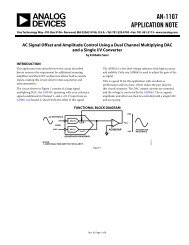EE Web PULSE
EE Web PULSE
EE Web PULSE
You also want an ePaper? Increase the reach of your titles
YUMPU automatically turns print PDFs into web optimized ePapers that Google loves.
INTERVIEW<br />
Phil: I really like the Array 3710<br />
programmable load and the Array<br />
3644 programmable bench supply.<br />
The two in combination allow for<br />
detailed analysis of battery charging<br />
and discharging characteristics.<br />
What are your favorite<br />
software tools that you use?<br />
Jeff: This may sound funny, but we<br />
use PowerPoint all the time to draw<br />
up specs on all sorts of things. For<br />
the most part, we’re not doing circuit<br />
level design, we’re specifying the<br />
physical design and the behavior.<br />
It allows us to work really quickly<br />
to build specifications on a wide<br />
range of components.<br />
Phil: I’m a hardware guy.<br />
What is the hardest/trickiest<br />
bug you have ever fixed?<br />
Jeff: For me, it is the actual<br />
manufacturing of components.<br />
We’re dealing with over 15<br />
suppliers and we’re trying to work<br />
with them to make the highest<br />
quality components. Even with<br />
simple components like phone<br />
adapters that you’d think should<br />
have zero problems, it turns out that<br />
sometimes the supplier solders a<br />
bit wrong, so it breaks if you bend<br />
it too far. We’re constantly getting<br />
samples, trying to break them,<br />
and making suggestions on how<br />
to manufacture them for better<br />
durability. I’d love to say that we<br />
have “fixed” this, but the reality<br />
is that we will always be making<br />
improvements to our components.<br />
Phil: Charging Apple products is a<br />
tricky affair, and it took a bit of reverse<br />
engineering and conversations with<br />
our suppliers to figure out. All the<br />
Apple products charge using OEM<br />
cables and docks, most of which<br />
plug into an AC power adapter via<br />
USB. What we learned was that all<br />
four pins of the USB connector are<br />
used to communicate to the Apple<br />
device telling it how much power it<br />
can draw, and these vary by Apple<br />
device. For the time being, we<br />
seem to have it all figured out, but<br />
with Apple constantly upgrading<br />
its products and changing its<br />
standard, who knows how long it<br />
will be before we have to figure it<br />
out all over again.<br />
It is incredibly<br />
liberating to realize<br />
that it’s possible<br />
to generate power<br />
without having to<br />
plug into a wall.<br />
What is on your bookshelf?<br />
Jeff: A lot of books on economic<br />
development, plus too many Nordic<br />
mystery novels. I use the <strong>Web</strong> for<br />
most of my engineering information.<br />
Phil: A healthy mix of electronic<br />
references, critical theory, sound<br />
and art theory, modern physics, and<br />
gardening books: A well worn copy<br />
of The Art of Electronics by Horowitz<br />
and Hill, several different selections<br />
from Don Lancaster’s Cookbook<br />
series, Baudrillard, Virillio, Zizek,<br />
Agamben, John Cage’s Silence,<br />
Harry Partch’s Genesis of a Music,<br />
How to Imagine by Gianfranco<br />
Baruchello, and The One-Straw<br />
Revolution by Masanobu Fukuoka<br />
are just a few of my favorites.<br />
What online resources<br />
do you use?<br />
Jeff: I spend a decent amount of<br />
time on Adafruit.com—sometimes<br />
for their technical explanations,<br />
which are simple, but written very<br />
well. I also look to them as a model<br />
for sharing information I’ve learned<br />
about almost anything, and sharing<br />
it with the world. We’re not as good<br />
as them at this and might not ever<br />
be, but we really love how open they<br />
are about sharing and teaching.<br />
Phil: Google. Whenever there’s a<br />
part (especially ICs) that I encounter<br />
in the field that I’m not familiar with,<br />
I pop the part number into Google<br />
and can usually pull up a datasheet<br />
a few clicks later. Wikipedia is also<br />
good for refreshing my memory and<br />
filling in any gaps in knowledge. If<br />
the answers aren’t in either of those<br />
places, I tend to turn to the books.<br />
Do you have any tricks<br />
up your sleeve?<br />
Phil: Unrelated to my work at Voltaic,<br />
I circuit bend devices (intentionally<br />
short circuit components) to<br />
induce erratic output. It’s an<br />
anti-engineering approach to<br />
producing art with electronics.<br />
You can see some images I’ve<br />
produced with low resolution digital<br />
cameras http://continentcontinent.<br />
cc/index.php/continent/article/<br />
viewArticle/27. Because we as a<br />
society haven’t fully dealt with the<br />
end-of-life issues of our electronic<br />
devices, fully functional machines<br />
can be found on the street awaiting<br />
trash collection. These discarded<br />
electronic devices are becoming<br />
fodder for a growing art movement<br />
<strong>EE</strong><strong>Web</strong> | Electrical Engineering Community Visit www.eeweb.com 5<br />
FEATURED INTERVIEW















